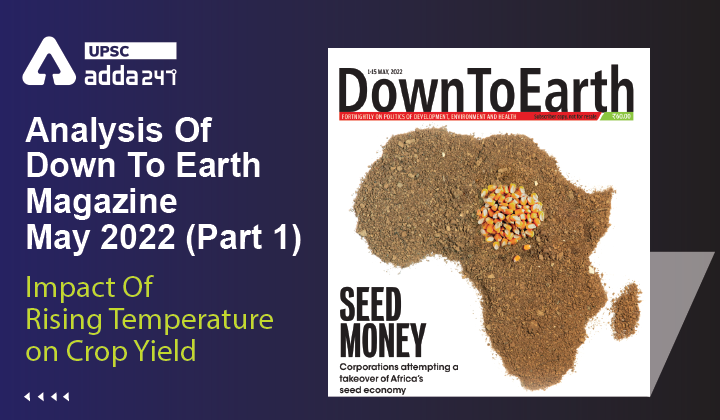Table of Contents
Analysis Of Down To Earth Magazine
”Impact Of Rising Temperature on Crop Yield”
Relevance
”GS 3: Disaster Management, Environmental Pollution & Degradation”
Context
- Above normal rains in January and record-shattering temperatures in March have reduced wheat yield throughout the country which resulted in price rise.
- Many other crops were also affected due to adverse climatic conditions.
Ideal Conditions for wheat Crop?
- Wheat requires cool and moist conditions for most of its growing period.
- The optimum temperature range for germination of wheat seed is 20-25 degree C.
- The crop is typically sown in late October or November and harvested in April.
- The grains develop in February and March.
What was unusual this year?
- But this year, India saw an early onset of summer, with large parts of central and western India recording 40 degrees C in March.
- The month was the warmest in 122 years, according to the India Meteorological Department (IMD).
- In the third week, maximum temperatures were 4.5 C above normal in the major wheat-producing regions of Punjab, Haryana, Rajasthan, West Madhya Pradesh and a few parts of Gujarat.
March Became May!
- Temperatures typically seen in May were observed in March this year.
- Due to which, Wheat crops matured 10-15 days earlier and the grain size remained short By the end of March, heatwaves had hit large swaths of north-western India and a few pockets of central India.
- The number of heatwave days during the month was significantly higher than normal, as per imd.
Rainfall Deficit
- Heatwaves typically strike north, north-west, central, east and northeast India in May.
- The month was also unusually dry, receiving the third-lowest rainfall since 1901.
- Overall, the country witnessed a “deficient” pre-monsoon (showers between March and May), with a deficiency of 32 per cent from March to April, compared to the normal range.
Adverse Impact Of Higher Temperature on Crop Yield
- High temperatures at night force plants to redirect energy meant for grain formation to transpiration—a process that helps keep plants cool.
- This tends to reduce the duration of grain filling and, as a result, the grains lose weight, leading to low yield.
What immediate reasons triggered the high temperatures in March and April?
- There were some changes in the atmospheric patterns.
- Anti-cyclones, which cause hot and dry weather by sinking winds around high-pressure areas, had formed over western parts of Rajasthan in March.
- Even western disturbances that bring showers were inactive this year.
Climate Change is Real
- There is enough study which shows that the main reason is climate change.
- One study published in Global Change Biology in 2018 found that a 1.5°C rise in temperatures could decrease global wheat production by 2.3-7 per cent.
- A 2021 paper published in the journal Geophysical Research Letters found that wheat yields in Punjab, Haryana and Uttar Pradesh could reduce by 12-27 per cent by 2100 if greenhouse gas emissions are not lowered.
Conclusion
We need to adapt cropping practices and develop heat-tolerant seed varieties, while also engaging in the larger mission to mitigate climate change.



 TSPSC Group 1 Question Paper 2024, Downl...
TSPSC Group 1 Question Paper 2024, Downl...
 TSPSC Group 1 Answer key 2024 Out, Downl...
TSPSC Group 1 Answer key 2024 Out, Downl...
 UPSC Prelims 2024 Question Paper, Downlo...
UPSC Prelims 2024 Question Paper, Downlo...





